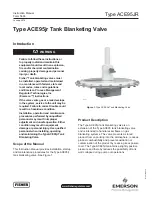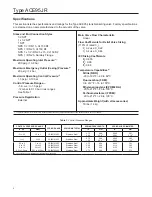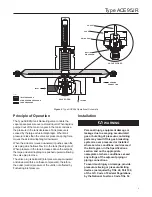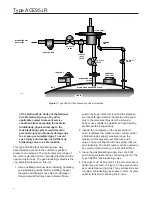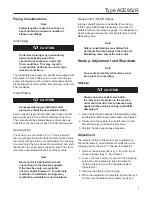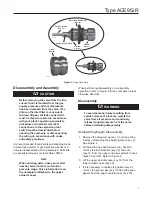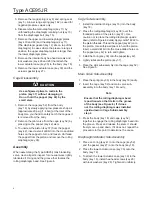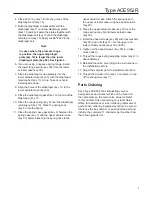
Type ACE95JR
8
5. Remove the range spring (key 8) and spring seat
(key 5). A lower range spring (key 162) is used for
negative pressure values only.
6. Disassemble the main diaphragm (key 11) by
unthreading the diaphragm retaining nut (key 13)
from the diaphragm bolt (key 15).
7.
Remove the upper and lower diaphragm plates
(keys 10 and 48) and the diaphragm (key 11).
[The diaphragm gasket (key 12) sits on top of the
diaphragm.] In cases where the pressure range is
positive, the upper diaphragm plate is larger than
the lower diaphragm plate.
8.
Remove the internal body hex-head screws and
lock washers (keys 29 and 28) that attach the
lower actuator case (key 30) to the body (key 18).
9.
Remove the lower actuator case (key 30) and the
actuator gasket (key 27).
Cage Disassembly
CAUTIOn
Use soft-jawed pliers to restrain the
piston (key 37) without damaging it.
Do not hold the poppet (key 42) by the
small stem.
1. Remove the cage (key 52) from the body
(key 18) by slowly applying low pressure shop air
[approximate 20 psig (1.4 bar)] at the inlet of the
body. Use your hand to safely catch the cage as it
is removed from the body.
2. Remove the pilot valve from the cage (key 52) by
pressing on the poppet (key 42) stem.
3.
To unscrew the piston (key 37) from the poppet
(key 42), insert a small drill bit into the cross-drilled
holes on the poppet to turn and loosen. Unthread
the poppet from the piston and remove the rolling
diaphragm (key 38).
Assembly
When assembling the Type ACE95jr tank blanketing
valve, clean all parts, inspect for unusual wear, lightly
lubricate all O-rings and the groove that locates the
rolling diaphragm bead. See Figure 6.
Cage Sub-Assembly
1.
Install the internal O-rings (key 16) into the body
(key 18).
2. Place the rolling diaphragm (key 38) over the
threaded portion of the piston (key 37). Use
caution not to place the rolling diaphragm upside
down (refer to Figure 6 detail). Apply Loctite
®
#222 to
the piston threads. Thread the poppet (key 42) onto
the piston. Use soft-jawed pliers to hold the piston.
Insert a small drill bit into the cross-drilled holes on
the poppet (key 42) to turn and tighten.
3.
Install the O-ring (key 39) onto the poppet (key 42).
4. Lightly lubricate the piston (key 37).
5. Place the pilot sub-assembly into the cage (key 52).
See Figure 5.
Main Valve Sub-Assembly
1. Place the spring (key 36) in the body (key 18) cavity.
2. Insert the cage (key 52) and main valve sub-
assembly into the body (key 18) cavity.
note
Ensure that the rolling diaphragm bead
is positioned so that it sits in the groove
of the body (see Figure 6). If it does
not, the rolling diaphragm was installed
upside-down in Cage Sub-Assembly
step 2.
3. Press the body (key 18) and cage (key 52)
together to engage the rolling diaphragm bead into
the groove. Press and release the stem. It should
freely move up and down. If it does not, repeat the
procedure to this point to determine the cause.
Diaphragm/Actuator Sub-Assembly
1.
Place an O-ring (key 41) onto the cage (key 52)
and the gasket (key 27) onto the body (key 18).
2.
Place the lower actuator case (key 30) onto the
body (key 18).
3.
To attach the lower actuator case (key 30) to the
body (key 18), install hex-head screws (key 29)
with lock washers (key 28). Tighten all uniformly.

